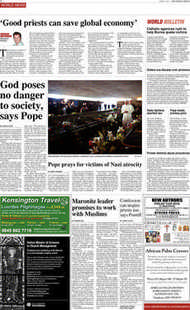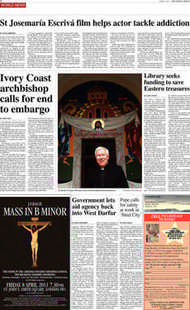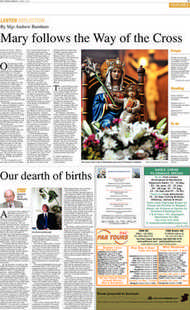Page 8, 1st April 2011
Page 8

Report an error
Noticed an error on this page?If you've noticed an error in this article please click here to report it.
Tags
Share
Related articles
Making Ready For Christmas
The Purpose Of The Confessional
Elizabeth Noel Explores The Psychology Behind The...
My Advice For Confessors
Bring Childlike Honesty To Confession
Why Hollywood is always at Confession
Confession scenes are more than a trusty cinematic device, says Sophie Lister. They also address a universal longing for forgiveness Filmmakers have always recognised the appeal of the confessional. It’s certainly a dramatic space: shadowy, intimate, filled with tense possibilities. Whether it’s a device to set a plot in motion or a chance to glimpse a character’s murky secrets, the confessional box can be the setting for a film’s most pivotal moments.
Catholic scholar Eileen Condon notes that in older films secrets told at Confession often served to provide a plot’s tension. The 1920 film Confession and Hitchcock’s I Confess (1953) both feature priests who are put in an impossible position by the binding secrecy of the confessional. These films draw their drama from a moral dilemma: is it ever right to break the seal? In Hitchcock’s film, the priest (Montgomery Clift) maintains a martyrlike silence, even when he finds himself framed for the very murder his church caretaker has confessed to. It’s the guilty man’s wife who lets the truth out in the end and justice is done without the need for compromise.
The controversial 1994 film Priest uses the same dramatic device, but its conclusions are rather different. When a struggling priest (Linus Roache) hears a young girl confess to experiencing abuse at home it seems that breaking the seal may be the right thing to do. “If I intervene,” he reasons, “I could stop someone suffering.” But how can he balance his duties with his desire to protect the child? The film clearly sees the secrecy of the confessional as a repressive force and a measure of human hypocrisy. The shadowy space conceals truths which might be better made known, just as the film’s characters hide their sin and shame while living openly respectable lives.
Some reacted against Priest by claiming that its use of the “seal dilemma” was clichéd and outdated. (American critic Roger Ebert even suggested, satirically, that the filmmakers’ knowledge on the topic was limited to a viewing of I Confess.) And indeed, the use of Confession scenes in this way seems to be dying out. For most contemporary audiences there is really no dilemma at all, and such tales are likely to become anti-religious parables: a falsely simplistic choice between compassionate truth and “repressive” rules.
Confession scenes continue to compel – not so much, now, for their plot possibilities, but perhaps due to a certain voyeuristic pleasure. What happens between priest and penitent ought to be by nature private, but when this intensely personal act is placed on screen it’s as though we have all crept into the booth to listen. Particularly in the public setting of a cinema, where the audience experiences the story collectively, the effect is potent. Shock ing revelations and whispered secrets all play to our love of scandal. In an era of reality television and celebrity magazines, we thrive on the act of soulbaring.
One of cinema’s best-known Confession scenes occurs in The Godfather: Part III (1990). Ageing mafia kingpin Michael Corleone (Al Pacino), apparently unable to retrace his steps along the path of violence he’s chosen, is given the opportunity to confess to the kindly Cardinal Lamberto (Raf Vallonne). Weighed down by his crimes, but convinced he is “beyond redemption”, Michael eventually concedes, breaking down as he stammers an account of his worst sins. The scene is filmed so as to cast the viewer as voyeur, the camera hidden behind the greenery, obscuring our view of the characters. In reality, they are in the open air, but from our perspective they are framed by a trellis, separated as though in a traditional confessional booth. These visual clues, along with the lowered tone of Michael’s voice and the dreadful nature of the secrets he imparts, give the audience an eavesdropper’s thrill. We are simultaneously repelled and drawn in dangerously close to the unfolding drama, yet safe from discovery. The scene is all the more powerful for its significance in the character’s journey. It does not represent a full redemption but crucially it shows us Michael’s remorse. The absolution he has been striving for seems suddenly within his reach.
It is this kind of Confession, the return of a prodigal to seek forgiveness or guidance at a moment of great crisis, which now seems to feature most prominently in films and television. Sam Tyler (John Simm) in the popular series Life On Mars speaks for many other characters when he begins his impromptu Confession with a disclaimer: “I’m not really what you’d call a religious man, Father. This isn’t even a Confession, it’s just... right now, I’m lost.” A recent episode of the medical drama House saw Dr Chase (Jesse Spencer), an agnostic with a Catholic past, wrestling with his conscience after killing a patient. Conflicted, he goes to Confession for the first time in years, seeking the moral certainty he fears he’s lost.
Walt (Clint Eastwood), the protagonist of Gran Torino (2008), doesn’t mask his cynicism about religion. Pestered by his local priest to attend Confession he doesn’t cave until the film’s final act, when a pair of scenes movingly reveal his guilt and sets him on the path to redemption. In the first he sits with the priest in a darkened booth, admitting that it has been “forever” since his last Confession, then speaking of his inadequacies as a father and husband. But it’s his second “confession”, spoken to his teenage friend through the grille of a basement door, which is truly revealing. “I got blood on my hands,” he admits, recalling those he killed in the Korean War. “I’m soiled.” As shorthand to convey its spiritual significance, the scene is deliberately staged and lit to recall a confessional. Many in the watching audience share the longings of characters like Sam, Chase and Walt. We all carry guilt and uncertainty, but our culture rarely allows us to acknowledge this. We’re expected to feel perpetually good about ourselves, to chart our own course independent of moral absolutes. “You only need to forgive yourself” becomes the mantra of Julia Roberts’s spiritual seeker Liz in Eat Pray Love (2010) – and yet something about this rings false. Many people, whatever they believe, sense that they have fallen foul of a moral standard which is greater than they are. We are drawn to stories of redemption and catharsis, just as lost and guilty characters are drawn, often despite themselves, to seek God’s forgiveness.
Confession scenes allow cinemagoers to glimpse something which the world can’t offer. Can we really unburden ourselves, be entirely freed from our crimes and regrets? When God’s grace breaks in, it suddenly becomes a possibility. “If we claim we have no sin,” 1 John 1 reminds us, “we are only fooling ourselves and not living in the truth. But if we confess our sins to him, he is faithful and just to forgive us our sins and to cleanse us from all wickedness.” Regardless of whether our culture realises it, we are still hungry for this compelling and wonderful truth. Sophie Lister is a researcher and writer for The Damaris Trust. For more articles and study guides see Culturewatch.org and Toolsfortalks.com
blog comments powered by Disqus





















